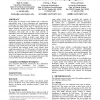Free Online Productivity Tools
i2Speak
i2Symbol
i2OCR
iTex2Img
iWeb2Print
iWeb2Shot
i2Type
iPdf2Split
iPdf2Merge
i2Bopomofo
i2Arabic
i2Style
i2Image
i2PDF
iLatex2Rtf
Sci2ools
WWW
2007
ACM
2007
ACM
Communication as information-seeking: the case for mobile social software for developing regions
In this paper, we describe several findings from a multi-year, multi-method study of how information and communication technologies have been adopted and adapted in Central Asia. We have found that mobile phone usage is outpacing the rate of Internet adoption, that access to the Internet is primarily through public access sites carrying with it issues regarding privacy and surveillance, that people rely on their social networks as information sources, that public institutions tend to be fairly weak as citizen resources, and that information seeking and communication are conflated in people's usage patterns with different technologies. In addition, in the developed world social networking software has grown rapidly and shown itself to have significant potential for mobilizing a population. Based on the collection of findings from Central Asia and observing patterns of technology usage in other parts of the world, our research leads to the conclusion that exploring mobile social so...
Internet Technology | Mobile Phone Usage | Mobile Social Software | World Social Networking | WWW 2007 |
| Added | 21 Nov 2009 |
| Updated | 21 Nov 2009 |
| Type | Conference |
| Year | 2007 |
| Where | WWW |
| Authors | Beth E. Kolko, Emma J. Rose, Erica J. Johnson |
Comments (0)

